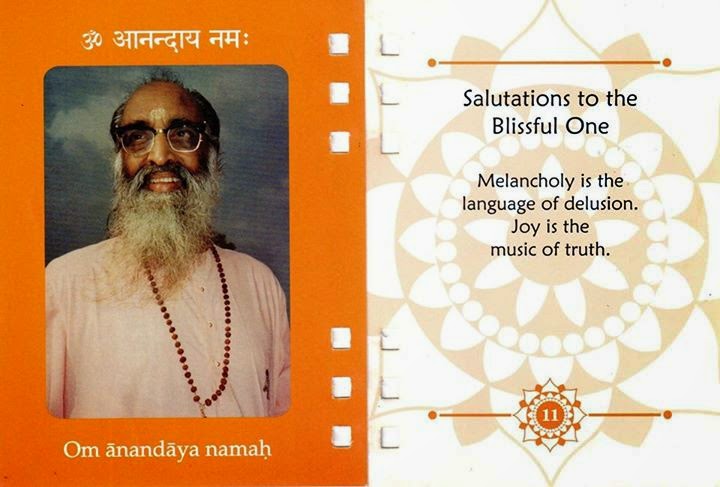Meditation According to the Upanishads - 10. Swami Krishnananda
========================================================================
--------------------------------------------------------------------------------------------------------------------------
14/02/2020.
Spoken on January 14th, 1973)
1.
The Vaishvanara Vidya is a concrete instance of the saprapancha view of the Chhandogya Upanishad, how the cosmos is to be regarded and contemplated as the body of the Supreme Being, while the teachings of Yajnavalkya primarily in the Brihadaranyaka Upanishad give us the nishprapancha or the acosmic view of Reality. There is no cosmos in Reality. It is acosmic, super-cosmic.
--------------------------------------------------------------------------------------------------------------------------
The Brihadaranyaka Upanishad
Chapter-2 - Section IV - Yajnavalkya and Maitreyi (I) - Mantram-14.
yatra hi dvaitamiva bhavati taditara itaraṃ jighrati, taditara itaraṃ paśyati, taditara itaram śrṇoti, taditara itaramabhivadati, taditara itaram manute, taditara itaraṃ vijānāti; yatra vā asya sarvamātmāivābhūttatkena kaṃ jighret, tatkena kaṃ paśyet, tatkena kaṃ śṛṇuyat, tatkena kamabhivadet, tatkena kaṃ manvīta, tatkena kaṃ vijānīyāt? yenedam sarvaṃ vijānāti, taṃ kena vijānīyāt? vijñātāram are kena vijānīyāditi || 14 ||
iti caturthaṃ brāhmaṇam ||
14. Because when there is duality, as it were, then one smells something, one sees something, one hears something, one speaks something, one thinks something, one knows something. (But) when to the knower of Brahman everything has become the Self, then what should one smell and through what, what should one see and through what, what should one hear and through what, what should one speak and through what, what should one think and through what, what should one know and through what? Through what should one know That owing to which all this is known—through what, O Maitreyī, should one know the Knower ?
Yatra hi dvaitam iva bhavati,
tad itara itaram pasyati.
yatra tv asya sarvam atmaivabhat,
tat kena kam pasyet (Brihad. 2.4.14).
Yajnavalkya tells us where we have an object in front of us, we can see.
Where there is no object in front of us, what do we see?
Yenedam sarva? vijanati, ta?
kena vijaniyat: How can we see that through which alone we are able to see everything?
This is the pinnacle of Upanishadic contemplation, the highest reaches of the Upanishads. With this, philosophy stops. We cannot go beyond it.
--------------------------------------------------------------------------------------------------------------------------
14/02/2020.
Spoken on January 14th, 1973)
Post-10.
-------------------------------------------------------------------------------------------------------------------------1.
The Vaishvanara Vidya is a concrete instance of the saprapancha view of the Chhandogya Upanishad, how the cosmos is to be regarded and contemplated as the body of the Supreme Being, while the teachings of Yajnavalkya primarily in the Brihadaranyaka Upanishad give us the nishprapancha or the acosmic view of Reality. There is no cosmos in Reality. It is acosmic, super-cosmic.
--------------------------------------------------------------------------------------------------------------------------
The Brihadaranyaka Upanishad
Chapter-2 - Section IV - Yajnavalkya and Maitreyi (I) - Mantram-14.
yatra hi dvaitamiva bhavati taditara itaraṃ jighrati, taditara itaraṃ paśyati, taditara itaram śrṇoti, taditara itaramabhivadati, taditara itaram manute, taditara itaraṃ vijānāti; yatra vā asya sarvamātmāivābhūttatkena kaṃ jighret, tatkena kaṃ paśyet, tatkena kaṃ śṛṇuyat, tatkena kamabhivadet, tatkena kaṃ manvīta, tatkena kaṃ vijānīyāt? yenedam sarvaṃ vijānāti, taṃ kena vijānīyāt? vijñātāram are kena vijānīyāditi || 14 ||
iti caturthaṃ brāhmaṇam ||
14. Because when there is duality, as it were, then one smells something, one sees something, one hears something, one speaks something, one thinks something, one knows something. (But) when to the knower of Brahman everything has become the Self, then what should one smell and through what, what should one see and through what, what should one hear and through what, what should one speak and through what, what should one think and through what, what should one know and through what? Through what should one know That owing to which all this is known—through what, O Maitreyī, should one know the Knower ?
Yatra hi dvaitam iva bhavati,
tad itara itaram pasyati.
yatra tv asya sarvam atmaivabhat,
tat kena kam pasyet (Brihad. 2.4.14).
Yajnavalkya tells us where we have an object in front of us, we can see.
Where there is no object in front of us, what do we see?
Yenedam sarva? vijanati, ta?
kena vijaniyat: How can we see that through which alone we are able to see everything?
This is the pinnacle of Upanishadic contemplation, the highest reaches of the Upanishads. With this, philosophy stops. We cannot go beyond it.
-------------------------------------------------------------------------------------------------------------------------
2.
While that is the stunning super-cosmic meditation of the Brihadaranyaka, the Chhandogya gives us a more sympathetic view suited to our own weaknesses because we cannot get rid of the idea that there is a world in front of us.
So the Upanishad tells us to contemplate the universe as unified in the Supreme Being. Both lead to the same goal. The study of the Upanishads is a very difficult thing. It requires a good philosophical background because they tell everything, for the matter of that.
There is no school of thought which is not touched upon in some Upanishad.
--------------------------------------------------------------------------------------------------------------------
3.
In connection with the meditations of the Mandukya, special mention has to be made also of a beautiful blend that it has brought about between meditation and recitation of Pranava, or Omkara. The chant of Om and the understanding of its relation to the three states of consciousness are regarded as necessary for the practice of this meditation.
The chant of Om is supposed to be constituted of three syllables, three morae, as they call it, three stresses of intonation. These three stresses of intonation of the chant of Om are identified with the three states of consciousness: waking, dream and sleep. Just as there are three states of consciousness, there are three stresses of Om chanting: A-U-M.
When they are put together and chanted in a blend, they become a single compound, Om, in the same way as the three states of consciousness, waking, dream and sleep, contemplated together become the Creator of the Universe.
The name of God is Om. Just as everything that is indicated has an indicator, Om is supposed to be a cosmic indicator of the Cosmic Being. While individual names particularise individual form, the Cosmic Being is denoted by the cosmic vibration of Om.
-----------------------------------------------------------------------------------------------------------------------
To be continued ...
=======================================================================



.jpg)

Comments
Post a Comment